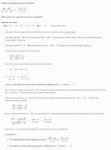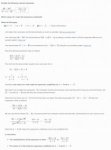The question is which values of n make the expression undefined:
-3(n +4)/n+5
No problem with the denominator...it is -5 which will make the denominator = 0. What I am having problems with in the numerator. The book says the correct answer is n=4...my answer was n=-4. I realize the numerator is negative but why should that matter if in the parenthesis (-4+4) = 0 . It then seems to me that it should not matter as -3*0 is still 0. Why does 4 (and not -4) make the numerator/expression undefined?
This is my first post so hope I formatted everything correctly. Thanks.
-3(n +4)/n+5
No problem with the denominator...it is -5 which will make the denominator = 0. What I am having problems with in the numerator. The book says the correct answer is n=4...my answer was n=-4. I realize the numerator is negative but why should that matter if in the parenthesis (-4+4) = 0 . It then seems to me that it should not matter as -3*0 is still 0. Why does 4 (and not -4) make the numerator/expression undefined?
This is my first post so hope I formatted everything correctly. Thanks.
Last edited by a moderator:


